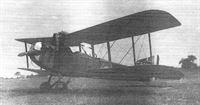
Jane's Encyclopedia of Aviation
Armstrong Whitworth F.K.8 (UK)
Subsequently nicknamed ‘Big Ack', the F.K.8 appeared in May 1916 as a large and sturdy armed-reconnaissance biplane, capable also of carrying up to 72.5 kg (160 lb) of bombs for ‘hit and run’ raids on enemy ground positions. Initial production aircraft, which became operational on the Western Front in early 1917, were powered by 89.4 kW (120 hp) Beardmore engines. Later production aircraft were normally powered by 119kW (160 hp) Beardmore engines in much neater cowlings with new small radiators on the fuselage sides. An unusual but much appreciated feature of the aircraft was its dual controls, which greatly improved the observer’s chances of survival.
In service F.K.8s proved capable of withstanding far more punishment than the Royal Aircraft Factory B.E.2s they at first replaced, and had the speed, manoeuvrability and firepower to give aircrews a reasonable chance of defending themselves. Indeed, the two VCs won by F.K.8 pilots - awarded to A. A. MacLeod and F. M. F'. West (see Chronology) - were for actions against formations of attacking enemy fighters. It is believed that more than 1,600 F.K.8s were built, serving on the Western Front, as home defence and training aircraft in the UK, in the Middle East and in India. Of these, nearly 700 were on strength at the end of the war.
Interestingly, after the war, two F.K.8s were among the initial equipment of Queensland and Northern Territory Aerial Services Ltd, which was subsequently known as QANTAS. These aircraft were used by the airline to carry air mail between Charleville and Cloncurry; this represented the Australian government’s second air mail contract. The first service took place during 2 and 3 November 1922.
Data: Engine as above Wing span 13.26 tn (43 ft 6 in) Length 9.58 m (31 ft 5 in) Max T-O weight 1,275 kg (2,811 lb) Max level speed 157 km/h (98 mph) Endurance 3 h Armament one forwardfiring Vickers machine-gun and one rear-mounted Lewis gun.
- Jane's Encyclopedia of Aviation
Фотографии
-
История Авиации 2002-04 / С.Спичак - Первые болгарские ВВС /На заре новой эры/ (4)
Регистрационный номер: B3339 "Армстронг-Уитворт" F.K.8 сер. N B3339 из состава 17-й или 47-й эскадрильи RAF, сбитый болгарской зенитной артиллерией летом или осенью 1918г.
-
Jane's All the World Aircraft 1980 / Encyclopedia of Aviation - Aircraft A-Z - v2
Регистрационный номер: B240 Armstrong Whitworth F.K.8.
-
Aeroplane Monthly 1978-11 / Personal album
Регистрационный номер: B3324 Armstrong Whitworth F.K.8 "Big Ack" B3324 displays the original form of undercarriage and the early radiators which extended from the top wing down the fuselage sides just behind the 120 h.p. Beardmore engine. Normally a reconnaissance aircraft, this example carries a diagonal bar marking across the rudder stripes, believed to be the marking of a training unit.
-
Aeroplane Monthly 1977-05 / Personal album
Регистрационный номер: B3306 Mr Clarke poses with his aerial camera in front of Armstrong Whitworth F.K.8 B3306. The F.K.8, along with the R.E.8, was the B.E.2e’s successor, and is seen here with the original inefficient radiators which ran up the fuselage sides and met in front of the top centre section. These were later replaced by more compact elements on fuselage sides alone. Also visible in this view is the camera access hole in the fuselage by the pilot's cockpit.
-
Aeroplane Monthly 1977-05 / Personal album
Регистрационный номер: B3312 Leonard Clarke passes a hand-held camera to the observer of Armstrong Whitworth F.K.8 B3312, from same production batch as B3306. A fixed Williamson L type aerial camera is already attached to the fuselage by the pilot's cockpit, aimed down through the wing root cutaway. The complex undercarriage fitted here was later replaced by a simpler vee-strut unit.
-
История Авиации 23 / С.Корж - Коммерческая авиация /Ретроспектива/ (9)
"Армстронг Уитворт" F.K.8 - приобретение двух подобных машин, собственно говоря, и позволило QANTAS получить контракт на перевозку правительственной почты по маршруту Чарлевилл - Клонкарри и выделиться среди десятка других подобных почти "любительских" авиакомпаний, образованных пилотами-ветеранами Первой Мировой.
-
Air Enthusiast 1996-07 / C.Ashworth, P.Green - Bournemouth Bases
Armstrong Whitworth FK.4 C84xx at ‘Bournemouth’, 1918.
-
Air Enthusiast 1996-11 / A.Thomas - Over All Things Everywhere
Регистрационный номер: C8636 [2] During World War One 82 Squadron flew the Armstrong Whitworth FK.8 on operations in France. C8636 at Argenvilliers in mid-1918 with Captain Fagan - the pilot on the right - and Lieutenant Ely - observer, on the left
-
Air Enthusiast 1996-11 / A.Thomas - Over All Things Everywhere
Регистрационный номер: C8636 [2] FK.8 C8636 ‘14’ at Bonneuil, probably in March 1918, with Sergeant Norton in the gunner’s cockpit.
-
Air Enthusiast 1996-11 / A.Thomas - Over All Things Everywhere
Rare flying view shows 82’s FK.8 ‘A’ on December 1, 1918, whilst being flown by Lieutenants Ramsbotliam and Boyes.
- Фотографии









